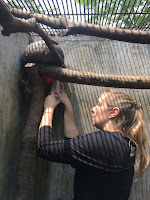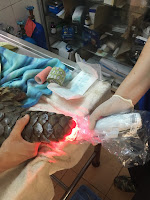Day 8
Day 8 was session 5 of light therapy. I dispensed and made up the required medication for all of the pangolins and carnivores first thing. Defrosting some ant eggs that they are fed and mixing the medication in before feeding to them.
My veterinary assistant for the day was again another of the volunteers who helped with careful restraint of the animals whilst I treated each of them. The light therapy and wound treatment took most of the morning. Not all of the pangolins co-operated with one sleeping outside at the top of a branch (which it did regularly), its tail wasn’t particularly accessible but we tried.
After lunch we anaesthetised an individual with respiratory disease to reassess. She was very difficult to assess conscious, as soon as she was disturbed she became very vocal hissing and grunting so it was impossible to auscultate her conscious. It is essential that they are cleaned out regularly as the build-up of ammonia can lead to respiratory disease and pneumonia. This is another major problem immediate post rescue as they have often been kept in large numbers in nets or cages with limited ventilation.
I finished an hour early and was able to explore the local surrounding area and visit the lake and view point just inside the National Park, a beautiful evening.
Dinner was with the rest of the volunteers; this was the best dinner yet, rice, spring rolls, chicken with pineapple and vegetables!
My veterinary assistant for the day was again another of the volunteers who helped with careful restraint of the animals whilst I treated each of them. The light therapy and wound treatment took most of the morning. Not all of the pangolins co-operated with one sleeping outside at the top of a branch (which it did regularly), its tail wasn’t particularly accessible but we tried.
After lunch we anaesthetised an individual with respiratory disease to reassess. She was very difficult to assess conscious, as soon as she was disturbed she became very vocal hissing and grunting so it was impossible to auscultate her conscious. It is essential that they are cleaned out regularly as the build-up of ammonia can lead to respiratory disease and pneumonia. This is another major problem immediate post rescue as they have often been kept in large numbers in nets or cages with limited ventilation.
I finished an hour early and was able to explore the local surrounding area and visit the lake and view point just inside the National Park, a beautiful evening.






Comments
Post a Comment